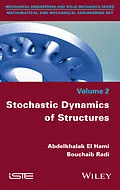This book is dedicated to the general study of the dynamics of mechanical structures with consideration of uncertainties. The goal is to get the appropriate forms of a part in minimizing a given criterion. In all fields of structural mechanics, the impact of good design of a room is very important to its strength, its life and its use in service. The development of the engineer's art requires considerable effort to constantly improve structural design techniques.
Autorentext
Abdelkhalak El Hami is Professor at the Institut National des Sciences Appliquées, Rouen, France. He is the author of many articles and books on optimization and uncertainty.
Bouchaib Radi is Professor in the Faculty of Sciences and Technology at the University of Hassan Premier, Settat, Morocco. His research interests are in such areas as structural optimization, parallel computation, contact problem and metal forming. He is the author of many scientific articles and books.
Inhalt
Preface xi
Chapter 1. Introduction to Structural Dynamics 1
1.1. Composition of problems relating to dynamic structures 2
1.1.1. Finite element method 4
1.1.2. Modal superposition method 5
1.1.3. Direct integration 6
1.2. Structural optimization 8
1.2.1. Design optimization 9
1.2.2. Shape optimization 9
1.2.3. Topological optimization 10
1.2.4. Definitions and formulation of an optimization problem 12
1.3. Structures with uncertain parameters 13
1.3.1. Monte Carlo simulation 14
1.3.2. Analytic method 15
1.3.3. Stochastic finite element method 15
1.3.4. Fluid logic method 16
1.3.5. Reliability method 17
1.3.6. Reliability optimization 21
1.4. Conclusion 23
Chapter 2. Decoupled Systems 25
2.1. Introduction 25
2.2. Problems with structural dynamics 25
2.2.1. Movement equation 25
2.2.2. Hooke's law 26
2.2.3. Variational formulation 27
2.2.4. Estimation by finite elements 27
2.2.5. Resolution in the frequency domain 28
2.2.6. Solution in the temporal domain 29
2.2.7. Reduction of the model 31
2.3. Acoustic problems 42
2.3.1. Wave equation: formulation pressure 42
2.3.2. Variational formulation 43
2.3.3. Estimation by finite elements 43
2.3.4. Solution in the frequency domain 44
2.3.5. Model fluid reduction 45
2.4. Conclusion 55
Chapter 3. Coupled Systems 57
3.1. Introduction 57
3.2. Mathematical formulation 57
3.2.1. Behavior equations 57
3.2.2. Conditions for fluidstructure coupling 58
3.3. Variational formulation 59
3.4. Estimation by finite elements 59
3.4.1. Estimation of unknown physical values 59
3.4.2. Integration of variational forms 60
3.5. Vibro-acoustic problem 60
3.6. Hydro-elastic problem 61
3.6.1. Calculation of the elementary matrix of the fluidstructure interaction 64
3.6.2. Dynamic study 65
3.7. Reduction of the model 67
3.7.1. Modal superposition method for the paired system 67
3.7.2. Direct calculation 71
3.7.3. Calculation with modal reduction 72
3.7.4. Modal synthesis method for paired systems 74
3.7.5. Direct numerical calculation 81
3.7.6. Numerical calculation with modal superposition 83
3.8. Conclusion 84
Chapter 4. Reliability and Meshless Methods in Mechanics 85
4.1. Introduction to non-networking methods 85
4.2. Moving least squares 88
4.2.1. Properties of MLS form function 94
4.2.2. Base functions 95
4.2.3. Weight functions 96
4.3. Galerkin mesh-free method 98
4.4. Imposition of essential limiting conditions 103
4.4.1. Variational principle modified with Lagrange multipliers 103
4.4.2. Variational principle modified without Lagrange multipliers 104
4.4.3. Variational principle with a charge 105
4.4.4. Connection with meshing of finite elements 106
4.5. Integration in the EFG method 107
4.6. Description of EFG method algorithms 109
Chapter 5. Mechanical Systems with Uncertain Parameters 115
5.1. Introduction 115
5.2. Monte Carlo simulation 116
5.3. Disturbance methods 116
5.3.1. Expansion into a second-order Taylor series 118
5.3.2. Muscolino distortion method 124
5.3.3. Disturbance methods and modal reduction methods 127
5.4. Projection onto polynomial chaos 131
5.4.1. Moments of the response function in frequency 134
5.4.2. Moments of dynamic response 135
5.4.3. Projection onto polynomial chaos with modal reduction 137
5.5. Conclusion 149
Chapter 6. Modal Synthesis Methods and Stochastic Finite ...
